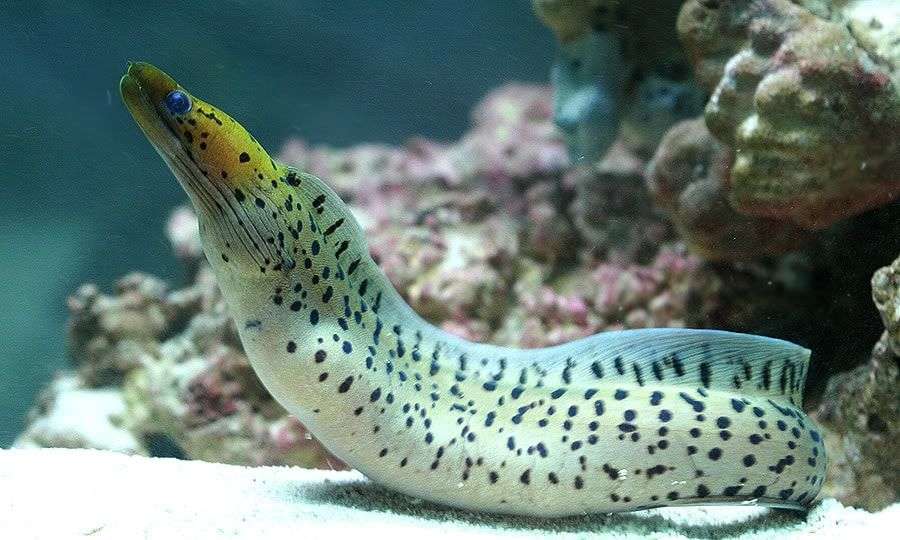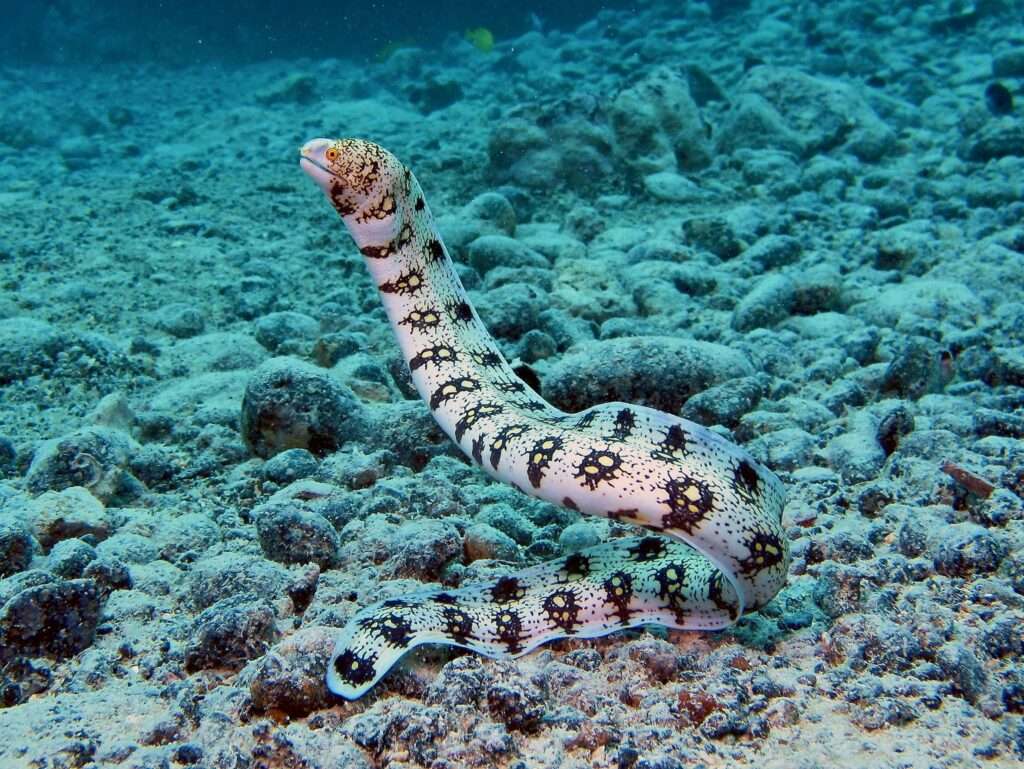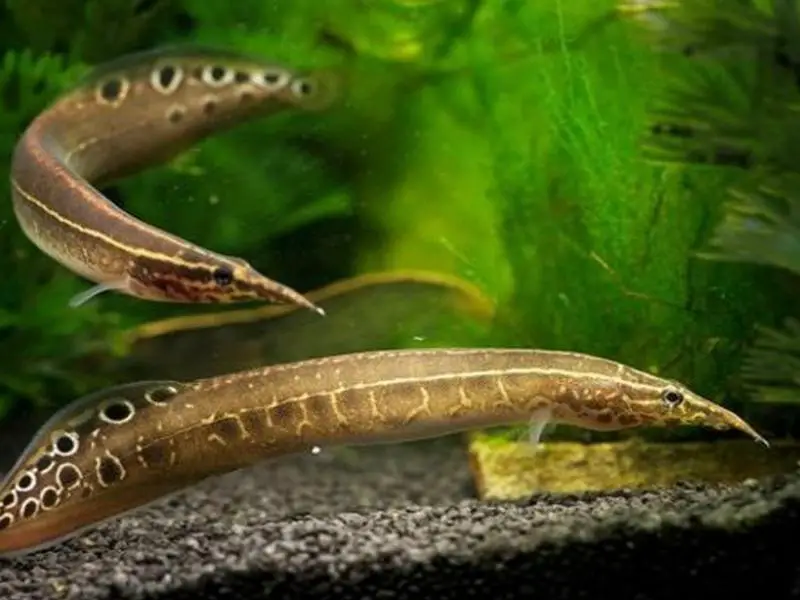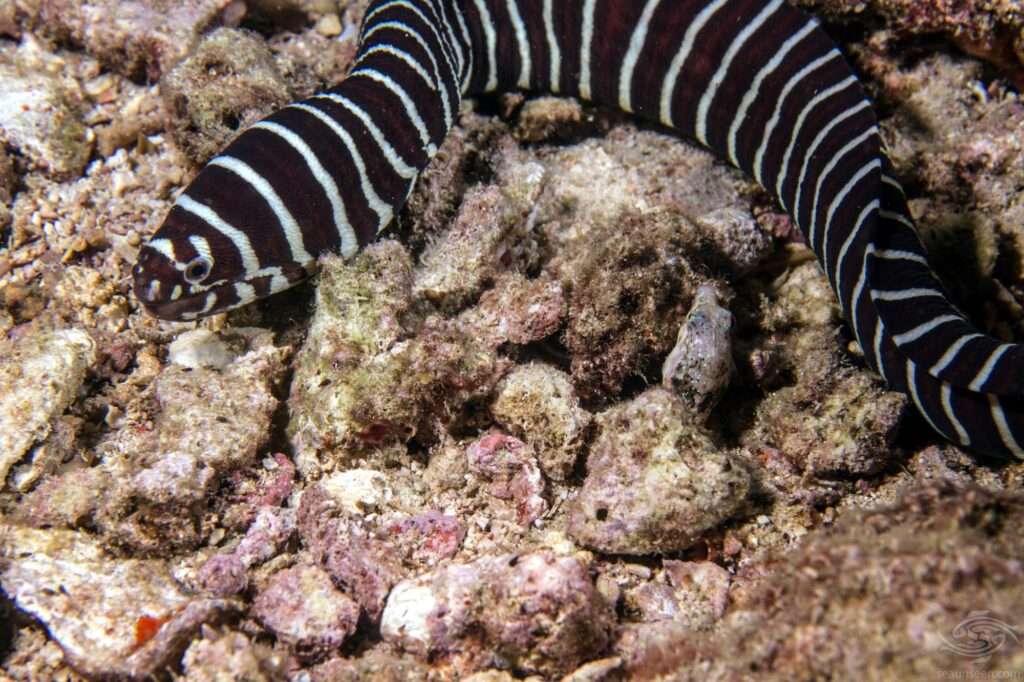
In general, the Fimbriated Moray Eel is light tan to grayish brown. In adults, the body is covered in irregularly spaced, variously sized spots and bars that range in color from brown to black. On the head area, there are sporadic spots of various sizes on the facial area. Although the heads of adults may have a slight yellow tint, juveniles have a clearly yellow head, a brown nose, larger markings, and unformed bars. Only the dorsal and anal fins, which run continuously down the top and bottom of the fish, are present on eels. They have excellent eyesight and very sharp teeth. With 128 to 142 vertebrae, the Fimbriated Moray Eel sounds like the chiropractor’s worst nightmare.
Due to their requirements and need for long-term care, they are more suited to intermediate aquarists. Fimbriated Moray Eels rank low on the list of preferred aquatic pets since they are quite cryptic. They emerge to eat, then retreat after they are satisfied. Even in the wild, it is uncommon to encounter very small youngsters. Fimbriated Moray Eels have been known to take down fish that are 20% their body length because of their razor-sharp teeth! They will twist, tug, thrash, and rotate their bodies to break the fish into smaller pieces if they can’t get it to go down their throats “head first.”
Several other predatory fish pursue eels as they hunt, taking advantage of the Fimbriated Moray’s unsuccessful attempt to catch a meal! While the naive fish might feel momentarily pleased to have avoided the eel’s razor-sharp jaws, his companion grouper, lion fish, or goatfish will soon swallow him whole. The eel favors nighttime hunting. Eels appear to be highly aggressive due to the unique way they breathe. They “inhale” water with their open lips, forcing it down and over their gills with their closed mouths.
Habitat
Bennett published the first description of the Fimbriated Moray Eel (Gymnothorax fimbriatus) in 1831. Their common names—Dark Spotted Moray, Yellowhead Moray Eel, Fimbriated Moray, Moray Eel, Spot-Face Moray, and Fimbriated Moray Eel—describe their pattern or species names. The juvenile to subadult coloration of the head is reflected in the name Yellowhead Moray. The Greek word for the genus name Gymnothorax, which translates to “bare breast,” makes me think of a muscle-bound man flexing in the mirror while wearing no shirt at the gym. However, as our eels are not allowed to join gyms, this probably alludes to the absence of scales for them.
The Indo-Pacific region, extending from Madagascar to the Society Islands, southern Japan, Queensland, Australia, and all of Micronesia, is home to the fimbriated moray eel. They can be found in caves or dead coral in protected inshore waters such as harbors, bays, gulfs, or even river basins. They can also be discovered in huge sponges, on steep sandy slopes, and patch reefs. Because they are so elusive, juveniles are rarely spotted. Although they typically live alone, adults have been seen to share hiding spots with White-eye Morays (Siderea thyrsoidea).
The Fimbriated Moray Eel can be found at water depths ranging from 23 to 163 feet (7 to 50 meters). It loves to hunt at night and eats fish, especially parrotfish, as well as crabs and shrimp.
Traits
The long, deep-bodied, scaleless Fimbriated Moray Eel has a continuous dorsal and anal fin. Adults can have 128 to 142 vertebrae and have a light tan or grayish brown color. The adult’s bodies contain irregularly shaped brown to black bars and dots, and their heads can have a very faint yellow tint. The dots on the head are dispersed and of varying sizes. The body color of juveniles is lighter, although they can have a brown snout, a more intensely colored head, more widely spaced black dots, and unformed body bars. The brown and yellow of the eel ages, and the larger spots on its body begin to fuse together to form vertical bars.
The lower jaw of the Fimbriated Moray Eel is somewhat bent, and it has sharp eyesight. The front of the jaws have a single row of teeth, with the lower jaw’s back having two pairs of long canines and the upper jaw’s back canines alternating with little pointy teeth. They have been observed to grow as tall as 31.5″ in the wild (80 cm).
Keeping as Pet

Face Difficulty to Keeping in Aquarium
Like most morays, the Fimbriated Moray Eels are simple to maintain. They are more suitable for more seasoned aquarists due to the difficulties in maintaining them due to tank size, lengthy lifespan, and mates. Feed them a variety of seafood from the grocery store, including fish, shrimp, and crustaceans. Till you can transition them to other meals, just feed them feeder shrimp or feeder fish like mollies to stimulate a feeding response. They will cease eating if the water is of poor quality. They require a sizable PVC or cave with a dark interior where they can hide and feel safe. Due to their scaleless bodies, fiberglass goods and drugs containing copper or organophosphates should not be used.
Foods
Carnivores include moray eels. Do not give them freshwater fish, such as goldfish, to eat. These foods are not very nutritious and will eventually make you sick. Feed them fresh squid, scallops, shrimp, marine fish flesh, and other marine flesh. Feed them every three to four days until they are satisfied. If you feed them more frequently than that, they may grow a fatty liver or throw up an additional meal, which will create a major mess in the tank. Juveniles need to be fed more frequently, every other day, and less frequently as they get older.
Table





